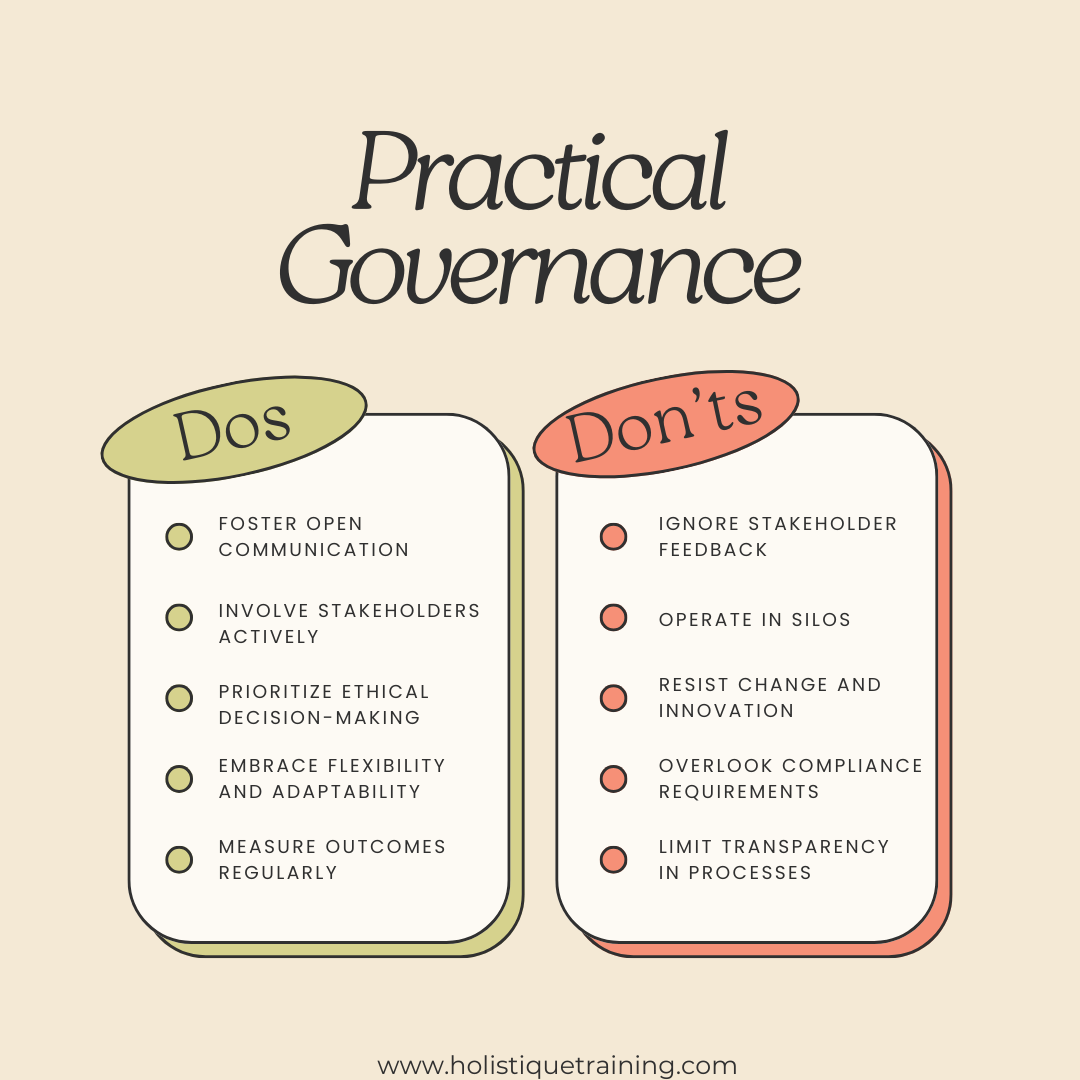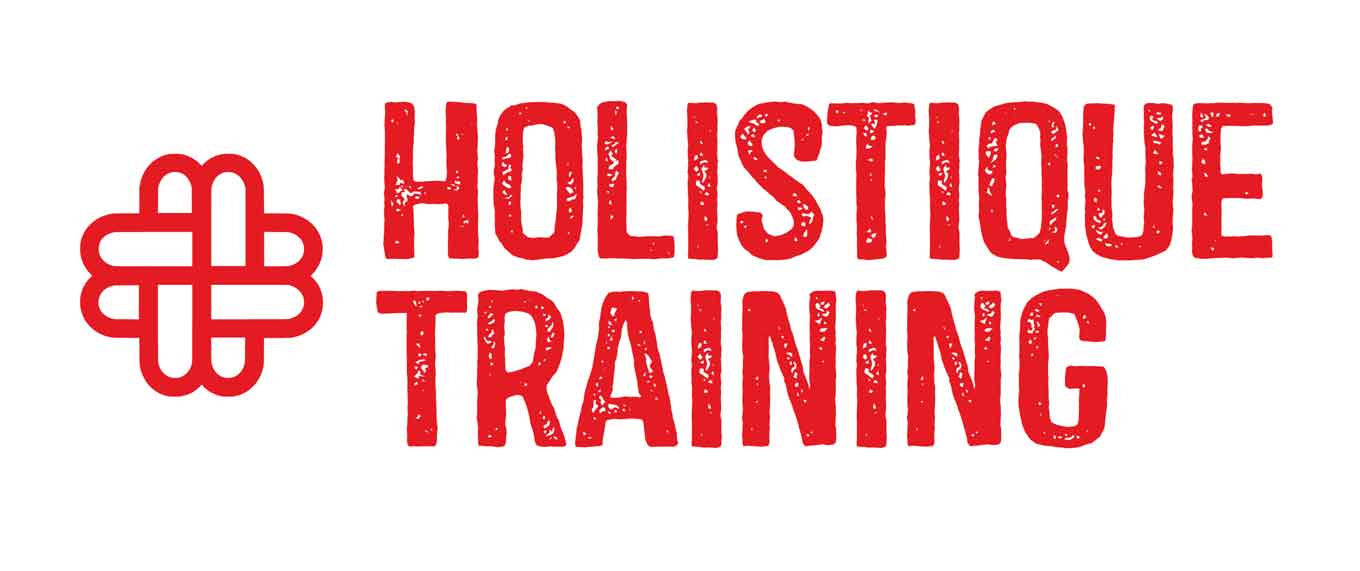- Table of Contents
- Introduction
- What is Practical Governance?
- Why is Practical Governance Important for Your Business?
- Risk Mitigation:
- Enhanced Decision-Making:
- Accountability and Transparency:
- Stakeholder Engagement:
- Sustainability and Long-Term Success:
- Adaptability in a Changing Environment:
- Improved Performance and Efficiency:
- How Can Business Leaders Adapt to Today’s Practical Governance?
- Embrace a Culture of Learning:
- Leverage Technology:
- Engage with Stakeholders:
- Develop Clear Policies and Procedures:
- Promote Ethical Leadership:
- Implement Continuous Improvement Processes:
- Foster Cross-Functional Collaboration:
- Stay Informed About Regulatory Changes:
- Practical Steps for Ethical Governance
- Establish a Code of Ethics:
- Provide Ethics Training:
- Encourage Open Communication:
- Implement Whistleblower Protections:
- Regularly Review Ethical Practices:
- Integrate Ethics into Performance Evaluations:
- Lead by Example:
- Create an Ethics Committee or Task Force:
- Foster a Culture of Accountability:
- Engage in Community and Social Responsibility:
- Integrating Risk Management into Governance
- Establish a Risk Management Framework:
- Involve Leadership in Risk Oversight:
- Conduct Regular Risk Assessments:
- Integrate Risk Management into Decision-Making:
- Develop a Risk Communication Strategy:
- Create Cross-Functional Risk Management Teams:
- Implement Risk Monitoring and Reporting:
- Cultivate a Risk-Aware Culture:
- Leverage Technology for Risk Management:
- Review and Adapt Risk Management Practices:
- Benefits of Stakeholder Engagement and How to Strengthen It
- Benefits of Stakeholder Engagement
- Strategies to Strengthen Stakeholder Engagement
- The Role of Training and Development in Governance Excellence
- Building Awareness of Governance Principles:
- Enhancing Skills for Ethical Decision-Making:
- Promoting Compliance and Risk Management:
- Fostering Leadership Development:
- Encouraging Continuous Learning:
- Facilitating Cross-Functional Collaboration:
- Implementing Performance Metrics:
- Embedding Governance in Onboarding Processes:
- Creating a Supportive Learning Environment:
- Evaluating and Updating Training Programs:
- Conclusion
Introduction
Navigating the complexities of modern business requires more than just strategic planning and operational efficiency. Business leaders are increasingly recognizing the importance of practical governance as a framework that not only enhances decision-making but also fosters a culture of accountability and ethical behavior. This blog post delves into the concept of practical governance, exploring its significance for contemporary businesses, how leaders can adapt to its principles, and the steps they can take to implement effective governance practices. By understanding the intricacies of practical governance, business leaders can ensure their organizations thrive in an ever-evolving landscape.
What is Practical Governance?
Practical governance refers to the systems, processes, and practices that guide an organization’s decision-making and accountability structures. Unlike traditional governance models that often focus on compliance and regulatory frameworks, practical governance emphasizes actionable strategies that can be integrated into daily operations. It encompasses a holistic approach to leadership that prioritizes transparency, ethical standards, and stakeholder engagement.
At its core, practical governance involves creating a framework that aligns the organization’s mission and values with its operational practices. This can include establishing clear policies, fostering open communication, and ensuring that all levels of the organization are aware of their roles and responsibilities. By doing so, businesses can create a culture of trust and integrity, which is essential for long-term success.
Why is Practical Governance Important for Your Business?
The significance of practical governance cannot be overstated. In a world where businesses face increasing scrutiny from regulators, customers, and stakeholders, effective governance is essential for maintaining credibility and fostering trust. Here are several reasons why practical governance is crucial for your business:
Risk Mitigation:
Practical governance helps identify and manage risks proactively. By implementing robust governance frameworks, businesses can anticipate potential challenges and develop strategies to address them before they escalate. This proactive stance not only protects the organization from unforeseen crises but also minimizes financial losses and reputational damage. For instance, companies with strong governance practices are better equipped to handle regulatory changes, market fluctuations, and operational disruptions, ensuring business continuity.
Enhanced Decision-Making:
A well-structured governance model provides leaders with the necessary tools and information to make informed decisions. This leads to more effective strategies and a greater likelihood of achieving business objectives. Practical governance involves establishing clear lines of authority and accountability, enabling leaders to access relevant data and insights that inform their choices. When decision-making processes are transparent and well-documented, it fosters a culture of collaboration and encourages input from diverse perspectives, ultimately leading to better outcomes.
Accountability and Transparency:
Practical governance promotes a culture of accountability, ensuring that all employees understand their roles and responsibilities. This transparency not only builds trust within the organization but also enhances the company’s reputation externally. When stakeholders see that a business operates with integrity and openness, they are more likely to engage positively with the organization. This is particularly important in today’s digital age, where information is readily accessible, and any misstep can quickly lead to public scrutiny.
Stakeholder Engagement:
Engaging stakeholders is a fundamental aspect of practical governance. By actively involving stakeholders in decision-making processes, businesses can better align their strategies with the needs and expectations of those they serve. This engagement can take many forms, including surveys, focus groups, and regular communication updates. When stakeholders feel their voices are heard and valued, it fosters loyalty and strengthens relationships, which can be crucial during challenging times.
Sustainability and Long-Term Success:
Organizations that prioritize practical governance are better positioned for long-term success. By embedding ethical practices and sustainability into their governance frameworks, businesses can create value for both their shareholders and society as a whole. Practical governance encourages companies to consider the broader impact of their decisions, promoting social responsibility and environmental stewardship. This forward-thinking approach not only enhances the organization’s reputation but also attracts socially conscious investors and customers who prioritize ethical business practices.
Adaptability in a Changing Environment:
The business landscape is constantly evolving due to technological advancements, regulatory changes, and shifting consumer preferences. Practical governance equips organizations with the agility to adapt to these changes. By fostering a culture of continuous improvement and learning, businesses can quickly pivot their strategies and operations in response to new challenges and opportunities. This adaptability is vital for staying competitive and relevant in an ever-changing market.
Improved Performance and Efficiency:
Effective governance structures streamline processes and improve overall organizational performance. When roles and responsibilities are clearly defined, employees can work more efficiently and collaboratively. Practical governance encourages the establishment of performance metrics and accountability systems that drive results. As a result, businesses can optimize their resources, reduce waste, and enhance productivity, ultimately leading to increased profitability.
In summary, practical governance is not merely a compliance requirement; it is a strategic imperative that drives organizational success. By understanding its importance, business leaders can implement governance frameworks that not only protect their organizations but also promote ethical practices, stakeholder engagement, and long-term sustainability. This holistic approach to governance is essential for thriving in today’s complex and dynamic business environment.

How Can Business Leaders Adapt to Today’s Practical Governance?
Adapting to contemporary practical governance requires business leaders to embrace a mindset of continuous improvement, flexibility, and proactive engagement. As the business environment evolves, leaders must be equipped with the skills and strategies to navigate the complexities of governance effectively. Here are several key strategies that leaders can implement to adapt to today’s practical governance landscape:
Embrace a Culture of Learning:
Leaders should foster an environment where continuous learning is encouraged and valued. This involves not only staying informed about best practices in governance but also promoting a culture where employees feel empowered to seek knowledge and share insights. Regularly scheduled workshops, seminars, and training sessions can help keep everyone updated on the latest trends, regulations, and ethical standards. By cultivating a culture of learning, organizations can better adapt to changes and ensure that all team members are equipped to contribute to governance practices.
Leverage Technology:
In today’s digital age, technology plays a pivotal role in enhancing governance practices. Business leaders should explore various technological solutions that facilitate data analysis, reporting, and communication. For instance, governance, risk management, andcompliance (GRC) software can streamline processes, improve data accuracy, and enhance visibility into governance activities. Additionally, using collaboration tools can help teams communicate more effectively and ensure that governance policies are easily accessible to all employees. By leveraging technology, organizations can improve efficiency and responsiveness in their governance efforts.
Engage with Stakeholders:
Building strong relationships with stakeholders is essential for effective governance. Leaders should actively seek feedback from employees, customers, investors, and community members to understand their perspectives and incorporate them into decision-making processes. This engagement can take many forms, including regular surveys, focus groups, and open forums for discussion. By fostering an inclusive environment where stakeholders feel valued and heard, organizations can align their governance strategies with the needs and expectations of those they serve, ultimately leading to better outcomes.
Develop Clear Policies and Procedures:
Establishing clear governance policies and procedures is vital for ensuring consistency and accountability across the organization. Business leaders should regularly review and update these policies to reflect changes in regulations, industry standards, and organizational goals. This includes not only compliance-related policies but also guidelines for ethical behavior, risk management, and stakeholder engagement. By having well-defined policies in place, organizations can ensure that all employees understand their roles and responsibilities, which in turn fosters a culture of accountability.
Promote Ethical Leadership:
Leaders set the tone for organizational culture and behavior. By exemplifying ethical decision-making and transparency, leaders can inspire their teams to uphold the same standards. This involves not only making ethical choices in their own actions but also actively promoting discussions about ethics within the organization. Leaders should encourage employees to voice concerns about unethical practices and create an environment where ethical behavior is recognized and rewarded. By prioritizing ethical leadership, organizations can build a strong foundation for practical governance.
Implement Continuous Improvement Processes:
Adapting to practicalgovernance is not a one-time effort; it requires ongoing evaluation and improvement. Business leaders should implement processes for regularly assessing the effectiveness of governance practices and identifying areas for enhancement. This can include conducting internal audits, soliciting feedback from stakeholders, and benchmarking against industry standards. By committing to continuous improvement, organizations can ensure that their governance frameworks remain relevant and effective in addressing emerging challenges.
Foster Cross-Functional Collaboration:
Encouraging collaboration across different departments and functions can enhance the effectiveness of governance initiatives. Leaders should create opportunities for cross-functional teams to work together on governance-related projects, allowing for diverse perspectives and expertise to inform decision-making. This collaborative approach not only strengthens governance practices but also promotes a sense of shared responsibility among employees, reinforcing the importance of governance throughout the organization.
Stay Informed About Regulatory Changes:
The regulatory landscape is constantly evolving, and business leaders must stay informed about relevant laws and regulations that impact their organizations. This involves not only monitoring changes at the local, national, and international levels but also understanding how these changes affect governance practices. Leaders should establish mechanisms for tracking regulatory updates and ensure that their organizations are prepared to adapt to new requirements. By being proactive in this regard, businesses can avoid compliance pitfalls and maintain their reputations.
In short, adapting to today’s practical governance requires a multifaceted approach that emphasizes learning, engagement, and continuous improvement. By embracing these strategies, business leaders can create a governance framework that is responsive to the dynamic business environment, ultimately positioning their organizations for long-term success. This adaptability not only enhances operational efficiency but also builds trust and credibility with stakeholders, ensuring that the organization thrives in an increasingly competitive landscape.
The following table compares practical governance with traditional governance, highlighting key aspects that differentiate the two approaches:
Aspect | Practical Governance | Traditional Governance |
Decision-Making Process | Emphasizes collaborative and inclusive decision-making | Often relies on top-down, hierarchical decision-making |
Adaptability | Flexible and responsive to changing circumstances | Rigid structures that may resist change |
Stakeholder Engagement | Actively involves stakeholders in governance processes | Limited engagement with stakeholders, often top-level focus |
Focus on Outcomes | Prioritizes measurable outcomes and continuous improvement | Emphasizes adherence to rules and procedures |
Transparency | Encourages open communication and transparency in actions | May lack transparency, with information often siloed |
Practical Steps for Ethical Governance
Implementing ethical governance practices is essential for building trust and credibility within an organization. Ethical governance not only helps prevent misconduct but also fosters a positive organizational culture that prioritizes integrity and accountability. Here are some practical steps that business leaders can take to promote ethical governance effectively:
Establish a Code of Ethics:
A well-defined code of ethics serves as a foundational document that outlines the organization’s values, principles, and expected behaviors. This code should clearly articulate the ethical standards that all employees are expected to uphold, including issues related to honesty, integrity, respect, and compliance with laws and regulations. It should be easily accessible to all employees and regularly communicated to reinforce its importance. Additionally, involving employees in the development of the code can enhance buy-in and ensure that it resonates with the entire workforce.
Provide Ethics Training:
Regular training sessions on ethical decision-making and compliance are crucial to ensuring that employees understand the importance of ethical governance and how to apply it in their roles. These training programs should include real-world scenarios and case studies that illustrate ethical dilemmas relevant to the organization’s operations. By equipping employees with the tools to navigate ethical challenges, organizations can foster a culture of integrity where individuals feel empowered to make ethical choices.
Encourage Open Communication:
Creating an open-door policy encourages employees to voice concerns or report unethical behavior without fear of retaliation. Leaders should actively promote a culture of transparency where employees feel safe discussing ethical dilemmas and raising questions about potentially questionable practices. Regularly scheduled meetings, anonymous suggestion boxes, and digital platforms for reporting concerns can facilitate this open dialogue. When employees know that their voices are heard and valued, they are more likely to engage in ethical behavior.
Implement Whistleblower Protections:
Establishing protections for whistleblowers is essential to ensure that employees feel safe reporting unethical practices. Organizations should have clear policies in place that outline how whistleblower reports will be handled and the protections available to those who come forward. This includes safeguarding against retaliation, maintaining confidentiality, and providing assurance that concerns will be taken seriously. By fostering an environment where employees can report wrongdoing without fear, organizations can uncover issues before they escalate and promote a culture of honesty.
Regularly Review Ethical Practices:
Business leaders should conduct regular assessments of their ethical governance practices to ensure they remain effective and relevant. This includes evaluating the effectiveness of the code of ethics, training programs, and reporting mechanisms. Organizations should seek feedback from employees about the perceived effectiveness of these practices and identify areas for improvement. By regularly reviewing and updating ethical practices, businesses can adapt to changing circumstances and reinforce their commitment to ethical governance.
Integrate Ethics into Performance Evaluations:
To underscore the importance of ethical behavior, organizations should integrate ethical considerations into performance evaluations and reward systems. This can include assessing employees not only on their achievements and results but also on their adherence to ethical standards and the organization’s values. Recognizing and rewarding ethical behavior publicly can reinforce the message that integrity is a core component of organizational success. This approach encourages employees to prioritize ethical decision-making in their daily activities.
Lead by Example:
Leadership plays a critical role in shaping organizational culture. Leaders should model ethical behavior in their actions and decision-making processes, demonstrating a commitment to the organization’s values. When leaders consistently act with integrity and uphold ethical standards, they set a powerful example for employees to follow. This leadership by example is vital for cultivating a culture of ethics within the organization, as employees are more likely to emulate the behaviors they observe in their leaders.
Create an Ethics Committee or Task Force:
Establishing an ethics committee or task force can provide dedicated oversight for ethical governance initiatives. This group can be responsible for developing, implementing, and monitoring ethical policies and practices within the organization. Additionally, the committee can serve as a resource for employees seeking guidance on ethical dilemmas and can facilitate discussions about ethical issues that arise. By having a dedicated team focused on ethics, organizations can reinforce their commitment to ethical governance and ensure that ethical considerations are integrated into decision-making processes.
Foster a Culture of Accountability:
Encouraging a culture of accountability is essential for promoting ethical governance. Leaders should emphasize that everyone in the organization is responsible for upholding ethical standards, regardless of their position. This includes holding individuals accountable for unethical behavior and addressing violations of the code of ethics promptly and transparently. When employees see that accountability is taken seriously, they are more likely to adhere to ethical practices and contribute to a culture of integrity.
Engage in Community and Social Responsibility:
Ethical governance extends beyond the organization itself; it involves being a responsible member of the community. Businesses should actively engage incorporate social responsibility (CSR) initiatives that align with their values and address social or environmental issues. By demonstrating a commitment to ethical practices in the broader community, organizations can enhance their reputation and strengthen their relationships with stakeholders. This engagement not only reflects positively on the organization but also reinforces the importance of ethical behavior among employees.
In summary, practical steps for ethical governance are crucial for fostering a culture of integrity and accountability within an organization. By establishing clear policies, providing training, encouraging open communication, and leading by example, business leaders can create an environment where ethical behavior is prioritized and valued. These practices not only enhance the organization’s reputation but also contribute to long-term success by building trust with employees, customers, and stakeholders. Ultimately, a strong commitment to ethical governance lays the foundation for sustainable growth and resilience in today’s complex business landscape.
Integrating Risk Management into Governance
Integrating risk management into governance is essential for organizations to navigate uncertainties and enhance their resilience. Effective governance frameworks that incorporate risk management processes enable organizations to identify, assess, and mitigate risks proactively, ensuring that they can achieve their strategic objectives while safeguarding their assets. Here are several key aspects of how to effectively integrate risk management into governance:
Establish a Risk Management Framework:
Organizations should develop a comprehensive risk management framework that outlines the processes, policies, and responsibilities for identifying and managing risks. This framework should be aligned with the organization's overall governance structure and strategic goals. It should define risk categories, assessment methodologies, and reporting mechanisms, ensuring that all stakeholders understand their roles in the risk management process. A well-structured framework provides clarity and consistency in how risks are addressed across the organization.
Involve Leadership in Risk Oversight:
Effective risk management requires strong leadership involvement. Business leaders and the board of directors should take an active role in overseeing risk management activities. This includes regularly reviewing risk assessments, understanding the organization’s risk appetite, and ensuring that appropriate resources are allocated to manage identified risks. By involving leadership in risk oversight, organizations can foster a culture of accountability and ensure that risk management is prioritized at all levels.
Conduct Regular Risk Assessments:
Organizations should implement a systematic process for conducting regular risk assessments to identify potential threats and vulnerabilities. This involves analyzing both internal and external factors that could impact the organization’s objectives. Risk assessments should be conducted at various levels, including strategic, operational, financial, and compliance risks. By regularly evaluating risks, organizations can stay ahead of emerging threats and adapt their governance strategies accordingly.
Integrate Risk Management into Decision-Making:
To effectively manage risks, organizations should integrate risk considerations into their decision-making processes. This means evaluating potential risks associated with strategic initiatives, investments, and operational changes before making decisions. Decision-makers should have access to relevant risk information and analysis, enabling them to weigh the potential benefits against the risks involved. By embedding risk management into decision-making, organizations can make more informed choices that align with their risk appetite.
Develop a Risk Communication Strategy:
Clear communication about risks is vital for effective governance. Organizations should establish a risk communication strategy that ensures relevant information is shared with stakeholders, including employees, management, and the board. This strategy should outline how risk information is reported, the frequency of updates, and the channels used for communication. Transparent communication fosters a shared understanding of risks and encourages collaboration in managing them.
Create Cross-Functional Risk Management Teams:
Integrating risk management into governance requires collaboration across various departments and functions. Organizations should establish cross-functional risk management teams that bring together representatives from different areas, such as finance, operations, compliance, and IT. These teams can work together to identify and assess risks from multiple perspectives, ensuring a comprehensive approach to risk management. Collaboration enhances the organization’s ability to respond to risks effectively and leverage diverse expertise.
Implement Risk Monitoring and Reporting:
Continuous monitoring of risks is essential for effective governance. Organizations should establish mechanisms for tracking identified risks and assessing the effectiveness of mitigation strategies. Regular reporting on risk status, including emerging risks and changes in risk profiles, should be provided to leadership and the board. This ongoing monitoring ensures that risk management efforts remain aligned with organizational objectives and allows for timely adjustments as needed.
Cultivate a Risk-Aware Culture:
Fostering a risk-aware culture is crucial for integrating risk management into governance. Organizations should encourage employees at all levels to recognize and report potential risks. This can be achieved through training programs, workshops, and awareness campaigns that emphasize the importance of risk management. When employees understand their role in identifying and managing risks, they are more likely to contribute to a proactive risk management environment.
Leverage Technology for Risk Management:
Technology can significantly enhance risk management efforts by providing tools for data analysis, risk modeling, and reporting. Organizations should explorerisk management software and analytics tools that enable them to assess risks more effectively and streamline reporting processes. By leveraging technology, organizations can improve their ability to identify trends, monitor risks in real-time, and make data-driven decisions.
Review and Adapt Risk Management Practices:
The risk landscape is constantly evolving, and organizations must be willing to review and adapt their risk management practices accordingly. Regularly evaluating the effectiveness of risk management processes and frameworks allows organizations to identify areas for improvement and implement necessary changes. This adaptability ensures that the organization remains resilient in the face of new challenges and uncertainties.
In conclusion, integrating risk management into governance is essential for organizations to thrive in an increasingly complex and uncertain environment. By establishing a robust risk management framework, involving leadership, conducting regular assessments, and fostering a risk-aware culture, organizations can effectively manage risks while pursuing their strategic objectives. This integration not only enhances decision-making and accountability but also builds resilience and trust among stakeholders, ultimately contributing to long-term success.
Benefits of Stakeholder Engagement and How to Strengthen It
Stakeholder engagement is a vital aspect of practical governance that can significantly impact an organization’s success. Engaging stakeholders fosters collaboration, builds trust, and enhances decision-making. Here are some benefits of stakeholder engagement and strategies to strengthen it:
Benefits of Stakeholder Engagement
- Informed Decision-Making: Engaging stakeholders provides valuable insights that can inform decision-making. By understanding the needs and concerns of stakeholders, leaders can make more informed choices that align with the interests of all parties involved.
- Enhanced Reputation: Organizations that actively engage with stakeholders are often viewed more favorably. This positive perception can enhance the organization’s reputation and attract new customers, investors, and partners.
- Increased Loyalty and Trust: Building strong relationships with stakeholders fosters loyalty and trust. When stakeholders feel valued and heard, they are more likely to support the organization and its initiatives.
- Improved Risk Management: Engaging stakeholders can help identify potential risks and challenges that may not be apparent to leadership. This collaborative approach allows for more comprehensive risk management strategies.
Strategies to Strengthen Stakeholder Engagement
- Identify Key Stakeholders: Leaders should identify and prioritize key stakeholders, including employees, customers, suppliers, investors, and community members. Understanding their interests and concerns is crucial for effective engagement.
- Utilize Multiple Communication Channels: Employing various communication channels—such as surveys, social media, town hall meetings, and newsletters—ensures that stakeholders can engage with the organization in ways that suit them best.
- Encourage Feedback: Actively seeking feedback from stakeholders demonstrates that their opinions are valued. Leaders should create opportunities for stakeholders to share their thoughts and suggestions.
- Be Transparent: Transparency is key to building trust with stakeholders. Leaders should communicate openly about the organization’s goals, challenges, and decision-making processes.
- Show Appreciation: Recognizing and appreciating stakeholder contributions fosters goodwill. Leaders should express gratitude for stakeholder involvement and highlight how their input has influenced decision-making.
The Role of Training and Development in Governance Excellence
Training and development are critical components of effective governance, as they equip employees and leaders with the knowledge, skills, and competencies necessary to uphold governance standards and drive organizational success. By investing in training and development initiatives, organizations can enhance their governance frameworks, foster a culture of accountability, and ensure compliance with regulatory requirements. Here are several key aspects highlighting the role of training and development in governance excellence:
Building Awareness of Governance Principles:
Training programs focused on governance principles help employees understand the importance of ethical behavior, compliance, and accountability. These programs should cover the organization’s governance structure, policies, and procedures, as well as relevant laws and regulations. By raising awareness of governance principles, organizations can ensure that all employees are informed about their roles and responsibilities in maintaining governance standards.
Enhancing Skills for Ethical Decision-Making:
Effective governance requires individuals to make informed and ethical decisions. Training programs can provide employees with frameworks and tools for ethical decision-making, helping them navigate complex situations. Case studies and real-world scenarios can be used to illustrate ethical dilemmas, encouraging participants to analyze options and consider the implications of their choices. By enhancing ethical decision-making skills, organizations empower employees to act in alignment with governance principles.
Promoting Compliance and Risk Management:
Training and development initiatives should emphasize the importance of compliance with laws, regulations, and internal policies. Employees need to understand the potential risks associated with non-compliance and the impact it can have on the organization. Training programs can cover topics such as regulatory requirements, risk assessment processes, and reporting mechanisms. By promoting compliance and risk management, organizations can reduce the likelihood of legal issues and enhance their governance framework.
Fostering Leadership Development:
Strong governance relies on effective leadership. Training and development programs should focus on cultivating leadership skills that align with governance excellence. This includes training on ethical leadership, communication, conflict resolution, and strategic decision-making. By developing leaders who prioritize governance and ethical behavior, organizations can create a positive organizational culture that reinforces governance principles throughout the hierarchy.
Encouraging Continuous Learning:
Governance is an evolving field, and organizations must stay abreast of changes in regulations, best practices, and emerging trends. Training and development initiatives should promote a culture of continuous learning, encouraging employees to seek new knowledge and skills related to governance. This can be achieved through workshops, seminars, online courses, and access to industry publications. By fostering continuous learning, organizations can ensure that their workforce remains informed and capable of adapting to changes in the governance landscape.
Facilitating Cross-Functional Collaboration:
Governance often involves multiple departments and functions within an organization. Training programs can facilitate cross-functional collaboration by bringing together employees from different areas to discuss governance-related issues and share best practices. This collaborative approach enhances communication and understanding of governance challenges across the organization, leading to more effective governance outcomes.
Implementing Performance Metrics:
To measure the effectiveness of training and development initiatives related to governance, organizations should implement performance metrics and evaluation processes. This includes assessing participants’ knowledge retention, behavior changes, and overall impact on governance practices. By collecting feedback and analyzing results, organizations can refine their training programs to ensure they meet the evolving needs of the workforce and align with governance objectives.
Here are some of the metrics that could be measured:
Metric | Description |
Knowledge Retention | Measures how well participants remember and apply what they learned |
Behavior Changes | Assesses changes in employee behavior and adherence to governance practices |
Participant Feedback | Collects insights from participants regarding the training effectiveness |
Impact on Governance Practices | Evaluates the overall influence of training on organizational governance outcomes |
Continuous Improvement | Monitors ongoing adjustments made to training programs based on evaluation results |
Embedding Governance in Onboarding Processes:
New employees should be introduced to the organization’s governance framework as part of their onboarding process. Training on governance principles, ethical standards, and compliance expectations should be integrated into orientation programs. By embedding governance training in onboarding, organizations can instill a strong governance culture from the outset, setting the tone for ethical behavior and accountability.
Creating a Supportive Learning Environment:
Organizations should foster a supportive learning environment where employees feel encouraged to seek guidance and ask questions related to governance. This can include mentorship programs, peer support networks, and access to resources that facilitate learning. By creating a culture that values learning and development, organizations can empower employees to take ownership of their governance responsibilities.
Evaluating and Updating Training Programs:
Regular evaluation and updating of training programs are essential to ensure their relevance and effectiveness. Organizations should solicit feedback from participants and stakeholders to identify areas for improvement. Additionally, training programs should be adjusted to reflect changes in regulations, industry standards, and organizational goals. By continuously refining training initiatives, organizations can maintain high standards of governance excellence.
In summary, training and development play a vital role in achieving governance excellence within organizations. By building awareness of governance principles, enhancing ethical decision-making skills, promoting compliance, and fostering leadership development, organizations can create a strong foundation for effective governance. Investing in training and development not only enhances individual competencies but also cultivates a culture of accountability and integrity, ultimately contributing to the long-term success and sustainability of the organization.
Conclusion
Practical governance is an essential framework for business leaders seeking to navigate the complexities of today’s corporate landscape. By understanding the principles of practical governance and implementing effective strategies, leaders can foster a culture of accountability, transparency, and ethical behavior within their organizations. The journey toward practical governance is ongoing, requiring a commitment to continuous improvement, stakeholder engagement, and ethical leadership. As businesses adapt to the evolving demands of their stakeholders and the broader environment, practical governance will serve as a guiding principle that enables organizations to thrive in an increasingly competitive world. By prioritizing governance excellence, business leaders can ensure their organizations are not only successful but also responsible and sustainable in the long run.

























